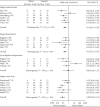The Effects of Obesity on Outcome in Preclinical Animal Models of Infection and Sepsis: A Systematic Review and Meta-Analysis
- PMID: 32211204
- PMCID: PMC7053456
- DOI: 10.1155/2020/1508764
The Effects of Obesity on Outcome in Preclinical Animal Models of Infection and Sepsis: A Systematic Review and Meta-Analysis
Abstract
Background: Clinical studies suggest obesity paradoxically increases survival during bacterial infection and sepsis but decreases it with influenza, but these studies are observational. By contrast, animal studies of obesity in infection can prospectively compare obese versus nonobese controls. We performed a systematic review and meta-analysis of animal investigations to further examine obesity's survival effect in infection and sepsis.
Methods: Databases were searched for studies comparing survival in obese versus nonobese controls. We performed a systematic review and meta-analysis of animal investigations to further examine obesity's survival effect in infection and sepsis. Methods. Databases were searched for studies comparing survival in obese versus nonobese animals following bacteria, lipopolysaccharide, or influenza virus challenges.
Results: Twenty-one studies (761 obese and 603 control animals) met the inclusion criteria. Obesity reduced survival in 19 studies (11 significantly) and the odds ratio (95% CI) of survival (0.21(0.13, 0.35); I 2 = 64%, p < 0.01p < 0.01p < 0.01) but with high heterogeneity. Obesity reduced survival (1) consistently in both single-strain bacteria- and lipopolysaccharide-challenged studies (n = 6 studies, 0.21(0.13, 0.34); I 2 = 64%, p < 0.01p < 0.01) but with high heterogeneity. Obesity reduced survival (1) consistently in both single-strain bacteria- and lipopolysaccharide-challenged studies (n = 6 studies, 0.21(0.13, 0.34); I 2 = 64%, p < 0.01p < 0.01) but with high heterogeneity. Obesity reduced survival (1) consistently in both single-strain bacteria- and lipopolysaccharide-challenged studies (n = 6 studies, 0.21(0.13, 0.34); I 2 = 64%, p < 0.01p < 0.01) but with high heterogeneity. Obesity reduced survival (1) consistently in both single-strain bacteria- and lipopolysaccharide-challenged studies (n = 6 studies, 0.21(0.13, 0.34); I 2 = 64%, p < 0.01p < 0.01p < 0.01) but with high heterogeneity. Obesity reduced survival (1) consistently in both single-strain bacteria- and lipopolysaccharide-challenged studies (n = 6 studies, 0.21(0.13, 0.34); I 2 = 31%, p=0.20 and n = 5, 0.22(0.13, 0.36); I 2 = 0%, p=0.59, respectively), (2) not significantly with cecal ligation and puncture (n = 4, 0.72(0.08, 6.23); I 2 = 75%, p < 0.01), and (3) significantly with influenza but with high heterogeneity (n = 6, 0.12(0.04, 0.34); I 2 = 73%, p < 0.01). Obesity's survival effects did not differ significantly comparing the four challenge types (p=0.49). Animal models did not include antimicrobials or glycemic control and study quality was low.
Conclusions: Preclinical and clinical studies together emphasize the need for prospective studies in patients accurately assessing obesity's impact on survival during severe infection.
Copyright © 2020 Wanying Xu et al.
Conflict of interest statement
The authors declare that they have no conflicts of interest.
Figures





References
-
- Ng M., Fleming T., Robinson M., et al. Global, regional, and national prevalence of overweight and obesity in children and adults during 1980–2013: a systematic analysis for the global burden of disease study 2013. Lancet (London, England) 2014;384(384):766–781. doi: 10.1016/S0140-6736(14)60460-8. - DOI - PMC - PubMed
Publication types
MeSH terms
LinkOut - more resources
Full Text Sources
Medical
Miscellaneous

